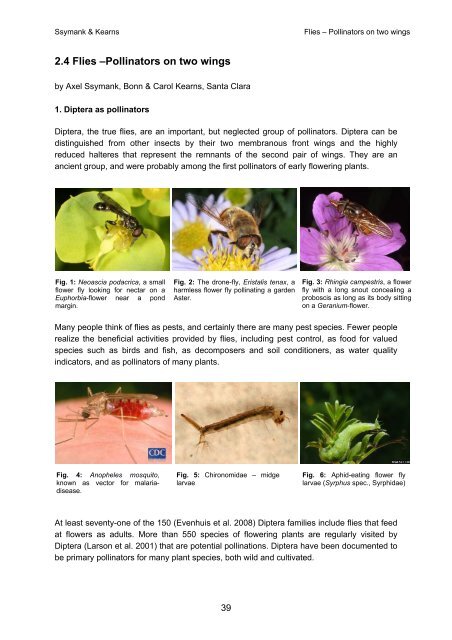Caring for Pollinators - Bundesamt für Naturschutz
Caring for Pollinators - Bundesamt für Naturschutz
Caring for Pollinators - Bundesamt für Naturschutz
Create successful ePaper yourself
Turn your PDF publications into a flip-book with our unique Google optimized e-Paper software.
Ssymank & Kearns Flies – <strong>Pollinators</strong> on two wings<br />
2.4 Flies –<strong>Pollinators</strong> on two wings<br />
by Axel Ssymank, Bonn & Carol Kearns, Santa Clara<br />
1. Diptera as pollinators<br />
Diptera, the true flies, are an important, but neglected group of pollinators. Diptera can be<br />
distinguished from other insects by their two membranous front wings and the highly<br />
reduced halteres that represent the remnants of the second pair of wings. They are an<br />
ancient group, and were probably among the first pollinators of early flowering plants.<br />
Fig. 1: Neoascia podacrica, a small<br />
flower fly looking <strong>for</strong> nectar on a<br />
Euphorbia-flower near a pond<br />
margin.<br />
Fig. 2: The drone-fly, Eristalis tenax, a<br />
harmless flower fly pollinating a garden<br />
Aster.<br />
Fig. 3: Rhingia campestris, a flower<br />
fly with a long snout concealing a<br />
proboscis as long as its body sitting<br />
on a Geranium-flower.<br />
Many people think of flies as pests, and certainly there are many pest species. Fewer people<br />
realize the beneficial activities provided by flies, including pest control, as food <strong>for</strong> valued<br />
species such as birds and fish, as decomposers and soil conditioners, as water quality<br />
indicators, and as pollinators of many plants.<br />
Fig. 4: Anopheles mosquito,<br />
known as vector <strong>for</strong> malariadisease.<br />
Fig. 5: Chironomidae – midge<br />
larvae<br />
Fig. 6: Aphid-eating flower fly<br />
larvae (Syrphus spec., Syrphidae)<br />
At least seventy-one of the 150 (Evenhuis et al. 2008) Diptera families include flies that feed<br />
at flowers as adults. More than 550 species of flowering plants are regularly visited by<br />
Diptera (Larson et al. 2001) that are potential pollinations. Diptera have been documented to<br />
be primary pollinators <strong>for</strong> many plant species, both wild and cultivated.<br />
39

















